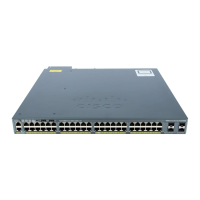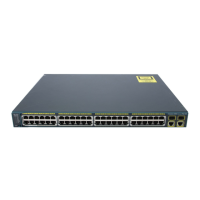Spanning-Tree Modes and Protocols
The switch supports these spanning-tree modes and protocols:
• PVST+—This spanning-tree mode is based on the IEEE 802.1D standard and Cisco proprietary extensions.
It is the default spanning-tree mode used on all Ethernet port-based VLANs. The PVST+ runs on each
VLAN on the switch up to the maximum supported, ensuring that each has a loop-free path through the
network.
The PVST+ provides Layer 2 load-balancing for the VLAN on which it runs. You can create different
logical topologies by using the VLANs on your network to ensure that all of your links are used but that
no one link is oversubscribed. Each instance of PVST+ on a VLAN has a single root switch. This root
switch propagates the spanning-tree information associated with that VLAN to all other switches in the
network. Because each switch has the same information about the network, this process ensures that the
network topology is maintained.
• Rapid PVST+—This spanning-tree mode is the same as PVST+ except that is uses a rapid convergence
based on the IEEE 802.1w standard. To provide rapid convergence, the Rapid PVST+ immediately
deletes dynamically learned MAC address entries on a per-port basis upon receiving a topology change.
By contrast, PVST+ uses a short aging time for dynamically learned MAC address entries.
Rapid PVST+ uses the same configuration as PVST+ (except where noted), and the switch needs only
minimal extra configuration. The benefit of Rapid PVST+ is that you can migrate a large PVST+ install
base to Rapid PVST+ without having to learn the complexities of the Multiple Spanning Tree Protocol
(MSTP) configuration and without having to reprovision your network. In Rapid PVST+ mode, each
VLAN runs its own spanning-tree instance up to the maximum supported.
• MSTP—This spanning-tree mode is based on the IEEE 802.1s standard. You can map multiple VLANs
to the same spanning-tree instance, which reduces the number of spanning-tree instances required to
support a large number of VLANs. The MSTP runs on top of the RSTP (based on IEEE 802.1w), which
provides for rapid convergence of the spanning tree by eliminating the forward delay and by quickly
transitioning root ports and designated ports to the forwarding state. In a switch stack, the cross-stack
rapid transition (CSRT) feature performs the same function as RSTP. You cannot run MSTP without
RSTP or CSRT.
Related Topics
Changing the Spanning-Tree Mode, on page 26
Supported Spanning-Tree Instances
In PVST+ or Rapid PVST+ mode, the switch or switch stack supports up to 128 spanning-tree instances.
In MSTP mode, the switch or switch stack supports up to 65 MST instances. The number of VLANs that can
be mapped to a particular MST instance is unlimited.
Related Topics
Disabling Spanning Tree, on page 28
Default Spanning-Tree Configuration, on page 25
Default MSTP Configuration, on page 58
Catalyst 2960-XR Switch Layer 2 Configuration Guide, Cisco IOS Release 15.0(2)EX1
OL-29424-01 23
Configuring Spanning Tree Protocol
Spanning Tree Protocol

